Trainee keeper blog: A little horsing around
04/05/2016 in Highland Wildlife Park
Many people believe that zoos are simply exhibitions of animals; an opportunity for the general public to see animals they would not usually come across in everyday life. However, when I started out as an education volunteer at the Highland Wildlife Park, I quickly learnt more about the wider roles zoos have to play, not only in education but also predominantly in the conservation of threatened species. The Przewalski’s wild horse is a prime example of this.
To summarise briefly, this species was declared extinct in the wild in the 1960s. Thankfully, however, a number of the species remained in captivity, which were then bred and a substantial captive population was created. This later led onto their reintroduction back into Mongolia, where their numbers are now increasing. These animals are still very vulnerable, and considered Endangered on the IUCN Red List, but it’s certainly a step in the right direction.
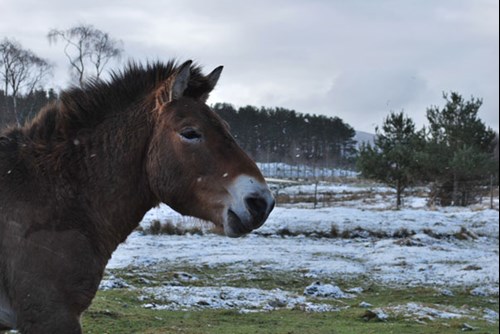
(Chagatai’s first stroll out in the reserve)
Most of our animals are part of international breeding programmes. These are managed by centralised studbooks so that the most genetically important, or viable, individuals from various collections can be paired together to produce healthy offspring. The Przewalski’s horses are one of these species and, over the last few months, our herd has changed quite a bit. The recommendation was that we bring a new stallion into the collection, as our previous stallion had bred many times and his genes were now well represented across the zoo community. It was also important for the son to be moved on from the herd before he fully matured, in case he bred with his mum or siblings.
Plans were made for Saqi, our young male, to move to a bachelor herd at Pitcastle estate, with one of their mature boys, Chagatai, moving in the other direction to start new life with his own herd of beautiful mares. It was also decided that our filly, Te-em, who was Saqi’s younger sister, would move down to Marwell Zoo, where she would join their herd in the hope that she would produce offspring in the future.
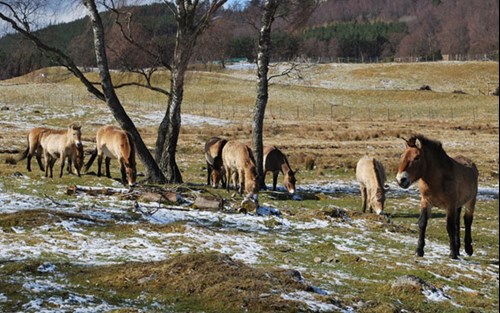
Once all the experts had chosen who was to go where, then came the challenge of moving them. As their name suggests, these horses are wild. They are not domestic horses which can simply be led into a horsebox – and even that can be tricky! These animals have lived on a substantial open reserve and have had very little handling; although, I should point out, our almost twenty-six year old matriarch, Sara, does enjoy a good brush to remove her winter coat… Nonetheless, we needed to come up with a plan to ensure the experience was as stress-free as possible for the animals.
The process began by separating Saqi from the herd and enticing him into an enclosure with handling facilities. Naturally, we used food for this and he was thankfully more than willing to follow us for a carrot. He was, however, understandably a little upset when the girls were let out and he wasn’t, but over the next few days we offered him plenty of enrichment to keep him occupied. It was then important to get Saqi to feel comfortable entering into a small run designed to allow safe handling for both the animal, vet and keeper. Again, carrots were very useful… Once comfortable in there, he was microchipped and given a check over by our vet. All that was left to do then was get him into the horsebox when it arrived.
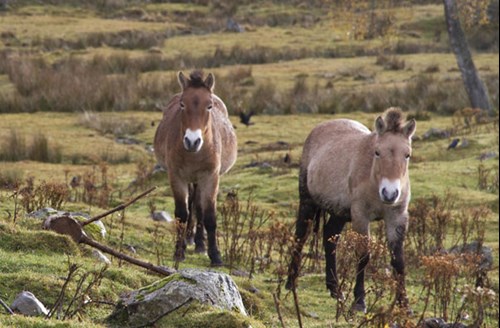
(Saqi (left) and Te-em (right) who have now left the herd)
The transport company that had come to collect Saqi also dropped off our new addition, Chagatai. He was released into a separate enclosure which allowed him to be quarantined for 30 days. He took everything in his stride and quickly settled into park life. The girls came over to observe him from afar and seemed impressed with the new addition.
We then needed to get Te-em separated for her trip down to Marwell. I was very grateful to be involved and the same procedures used with Saqi were applied to her. Although she is known to be a little more flighty than Saqi, we were delighted that loading her went as well as it did with him.
Although this all sounds very clinical and matter of fact, it’s not without emotion. Saying goodbye to animals that you were lucky enough to see born and raised is very difficult, even though we were soon informed that both horses arrived safely at their destinations and are integrating well. As a keeper, the consolation is understanding the importance of this within the wider breeding programme. Not to mention, as one (horsebox) door closes, another opens… and we are delighted to welcome Chagatai to the Park.
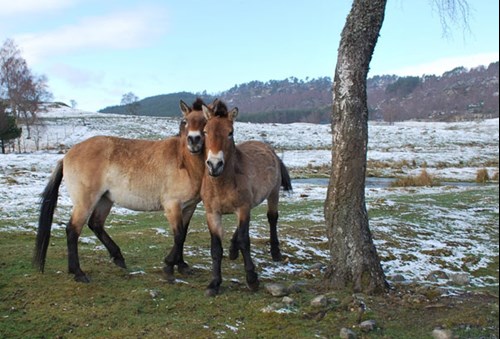
(Sara (left) welcoming Chagatai (right) to the park)
Chagatai was finally introduced to the girls after his quarantine period came to an end and Sara gave him a very warm welcome indeed. She walked him through his first day on the reserve and kept him close, despite his eagerness to explore. He seemed a little overwhelmed with his new herd at first, particularly as an old injury means he is blind in one eye. A couple of the mares took advantage of this but, within a few days, he had successfully kicked them into touch. Luckily Pitcastle estate is also home to European bison and red deer, meaning he was already familiar with his new housemates, which helped make his transition even easier. Saying that, Chagatai quickly learnt the hard way that our bison bull doesn’t like to share his food… thankfully, only his pride was harmed.
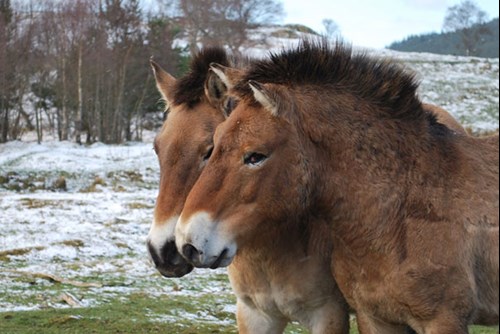
(Sara (left) welcoming Chagatai (right) to the park)
So our herd now stands at one stallion, four adult mares and their three foals from last year. With more foals on the way, it is likely the dynamic of our herd will change all over again soon. We hope that one day the horses bred at our collection may be candidates for reintroduction, which will make all the horsing around worthwhile.
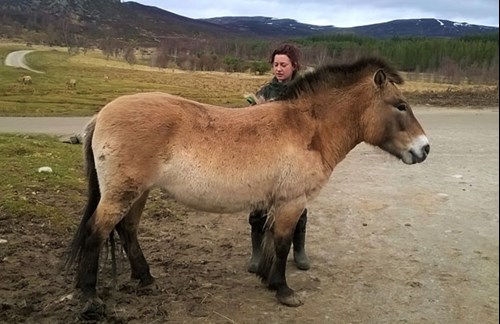
(Gemma brushing Sara, our “wildest” horse)
Gemma
Trainee Keeper at RZSS Highland Wildlife Park
Featured Articles

An update from the Budongo Forest
19/04/2024 in Conservation

Edinburgh Zoo named best zoo in Scotland
15/04/2024 in Edinburgh Zoo
Latest News
-
Blog

29/03/2024
Bug’s the word
For many people the sight, or perhaps even just the thought, of bugs can be enough to make you feel a little uneasy. Invertebrates are an important part of our ecosystems but helping everyone feel the love for them can be a bit tricky.
-
Blog

20/01/2024
Penguin Awareness Day 2024
Edinburgh Zoo is home to the largest outdoor penguin pool in Europe, with three different species and over 100 individuals. This penguin awareness day get to know some of the famous faces in the colony who you can also watch live on our penguin cam.
-
Blog

03/07/2023
Improving chimp behaviour with a fission fusion management process
Congratulations to our incredible Budongo team for winning the Bronze Behaviour & Welfare BIAZA Award this year! The award recognised their efforts in the implementation of a fission-fusion management process with the chimpanzees here at Edinburgh Zoo, to improve behaviour and integration within the troop. In this blog, Budongo Team Leader Callum explains what fission-fusion is and how he and the rest of the team went about implementing it.
-
Blog

03/03/2019
Pine hoverfly conservation at Highland Wildlife Park
We have an exciting new species in our charge here at the Park, the pine hoverfly!

























Follow EZ